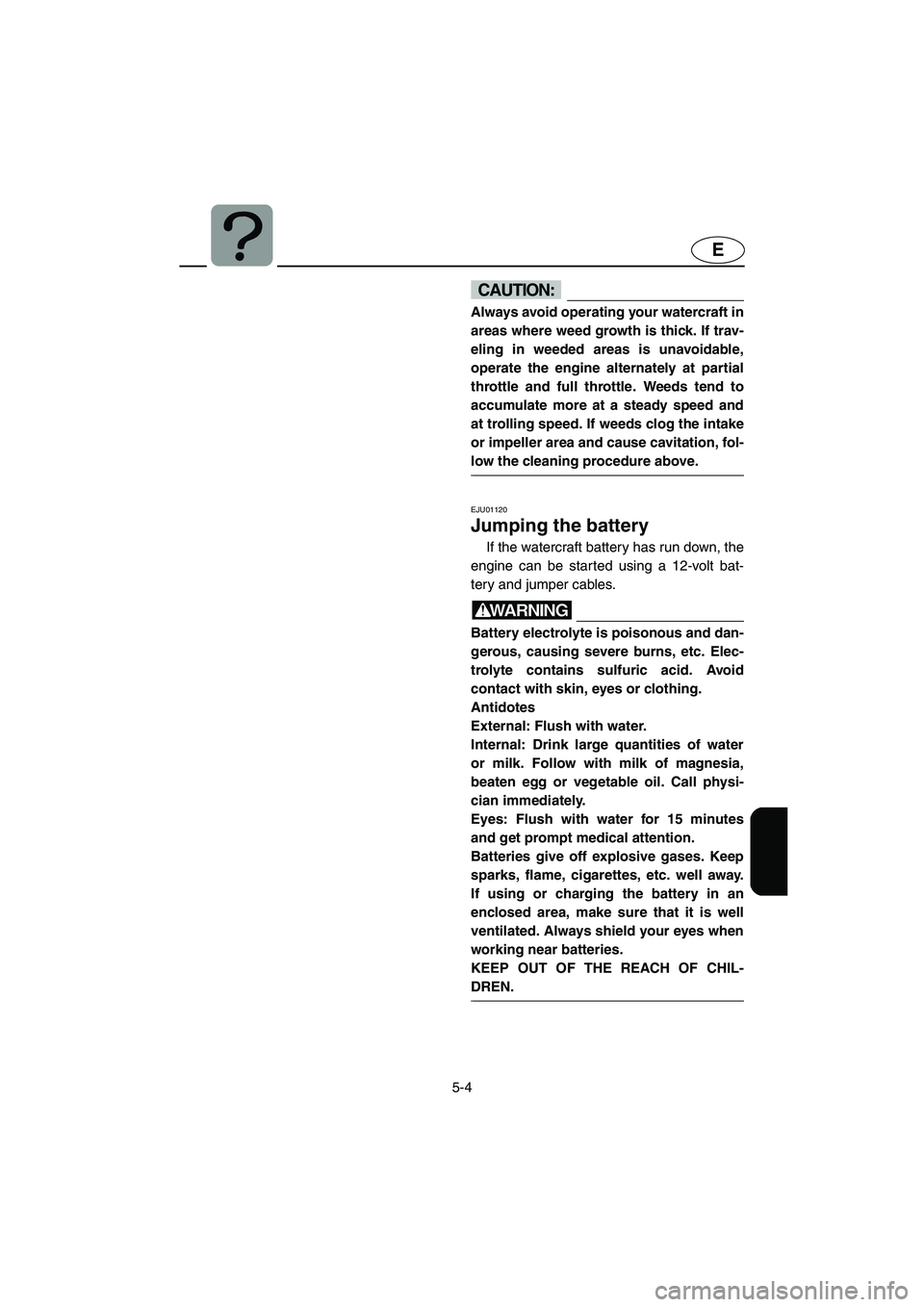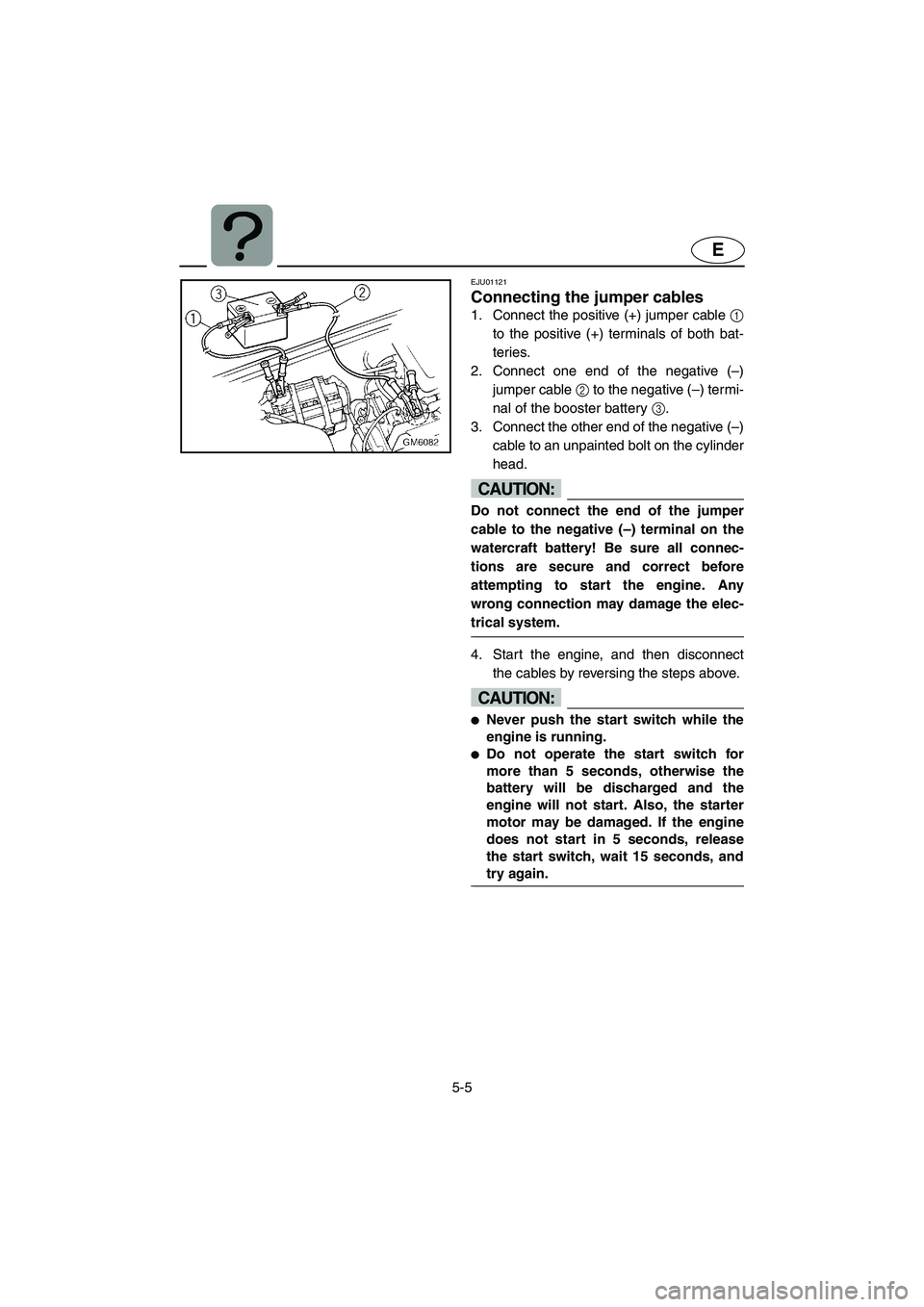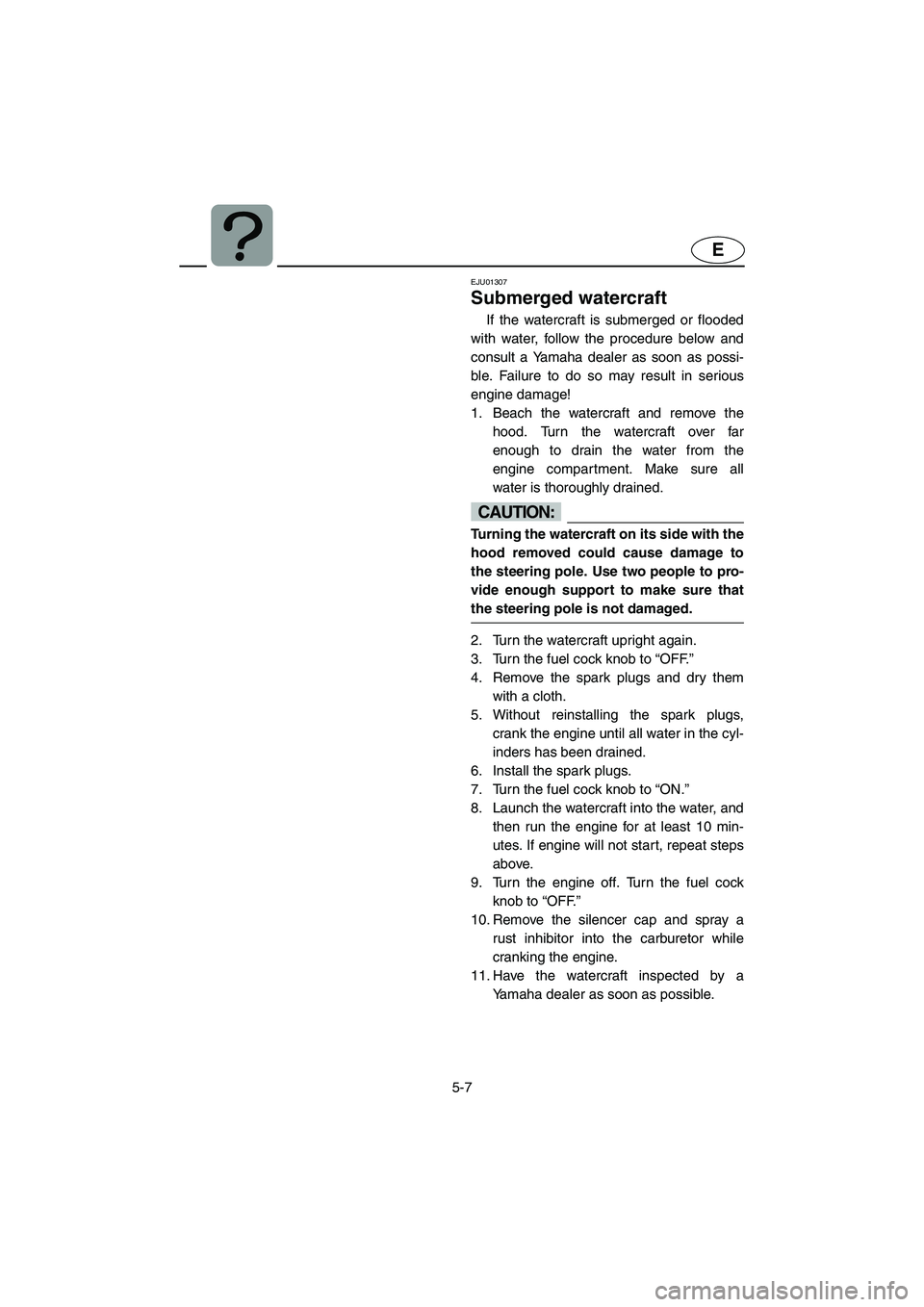Page 97 of 106

5-4
E
CAUTION:@ Always avoid operating your watercraft in
areas where weed growth is thick. If trav-
eling in weeded areas is unavoidable,
operate the engine alternately at partial
throttle and full throttle. Weeds tend to
accumulate more at a steady speed and
at trolling speed. If weeds clog the intake
or impeller area and cause cavitation, fol-
low the cleaning procedure above.
@
EJU01120
Jumping the battery
If the watercraft battery has run down, the
engine can be started using a 12-volt bat-
tery and jumper cables.
WARNING@ Battery electrolyte is poisonous and dan-
gerous, causing severe burns, etc. Elec-
trolyte contains sulfuric acid. Avoid
contact with skin, eyes or clothing.
Antidotes
External: Flush with water.
Internal: Drink large quantities of water
or milk. Follow with milk of magnesia,
beaten egg or vegetable oil. Call physi-
cian immediately.
Eyes: Flush with water for 15 minutes
and get prompt medical attention.
Batteries give off explosive gases. Keep
sparks, flame, cigarettes, etc. well away.
If using or charging the battery in an
enclosed area, make sure that it is well
ventilated. Always shield your eyes when
working near batteries.
KEEP OUT OF THE REACH OF CHIL-
DREN.
@
E_F1N-70.book Page 4 Wednesday, July 18, 2001 3:28 PM
Page 98 of 106

5-5
E
EJU01121
Connecting the jumper cables
1. Connect the positive (+) jumper cable 1
to the positive (+) terminals of both bat-
teries.
2. Connect one end of the negative (–)
jumper cable 2 to the negative (–) termi-
nal of the booster battery 3.
3. Connect the other end of the negative (–)
cable to an unpainted bolt on the cylinder
head.
CAUTION:@ Do not connect the end of the jumper
cable to the negative (–) terminal on the
watercraft battery! Be sure all connec-
tions are secure and correct before
attempting to start the engine. Any
wrong connection may damage the elec-
trical system.
@
4. Start the engine, and then disconnect
the cables by reversing the steps above.
CAUTION:@ �Never push the start switch while the
engine is running.
�Do not operate the start switch for
more than 5 seconds, otherwise the
battery will be discharged and the
engine will not start. Also, the starter
motor may be damaged. If the engine
does not start in 5 seconds, release
the start switch, wait 15 seconds, and
try again.
@
E_F1N-70.book Page 5 Wednesday, July 18, 2001 3:28 PM
Page 99 of 106

5-6
E
EJU01306
Towing the watercraft
If the watercraft becomes inoperative in
the water, it can be towed to shore.
If the watercraft must be towed in an
emergency using a tow line, the operator
should ride the watercraft, holding onto the
handlebars and supporting his body weight
on the riding tray. This will help keep the bow
of the watercraft out of the water.
CAUTION:@ �Tow the watercraft slowly; water may
enter the air intake and flood the
engine compartment if the watercraft
is towed too fast.
�Tow the watercraft using the rope
hole1 only.
�The bow must be kept up out of the
water during towing to prevent water
from entering the engine compart-
ment.
@
WARNING@ �The watercraft should only be towed in
an emergency.
�The tow line should be long enough so
that the watercraft will not collide with
the towing boat when slowing down. A
good rule of thumb is a tow line which
is three times the combined length of
the towing boat and the watercraft. A
shorter length of rope can be used if
the watercraft is towed very slowly.
�The operator of the towing boat must
keep speed to a minimum and avoid
traffic or obstacles which could be a
hazard to the operator on the water-
craft.
@
E_F1N-70.book Page 6 Wednesday, July 18, 2001 3:28 PM
Page 100 of 106

5-7
E
EJU01307
Submerged watercraft
If the watercraft is submerged or flooded
with water, follow the procedure below and
consult a Yamaha dealer as soon as possi-
ble. Failure to do so may result in serious
engine damage!
1. Beach the watercraft and remove the
hood. Turn the watercraft over far
enough to drain the water from the
engine compartment. Make sure all
water is thoroughly drained.
CAUTION:@ Turning the watercraft on its side with the
hood removed could cause damage to
the steering pole. Use two people to pro-
vide enough support to make sure that
the steering pole is not damaged.
@
2. Turn the watercraft upright again.
3. Turn the fuel cock knob to “OFF.”
4. Remove the spark plugs and dry them
with a cloth.
5. Without reinstalling the spark plugs,
crank the engine until all water in the cyl-
inders has been drained.
6. Install the spark plugs.
7. Turn the fuel cock knob to “ON.”
8. Launch the watercraft into the water, and
then run the engine for at least 10 min-
utes. If engine will not start, repeat steps
above.
9. Turn the engine off. Turn the fuel cock
knob to “OFF.”
10. Remove the silencer cap and spray a
rust inhibitor into the carburetor while
cranking the engine.
11. Have the watercraft inspected by a
Yamaha dealer as soon as possible.
E_F1N-70.book Page 7 Wednesday, July 18, 2001 3:28 PM
Page 101 of 106
E
6
EJU01124
APPENDIX
Index........................................................... 6-1
E_F1N-70.book Page 1 Wednesday, July 18, 2001 3:28 PM
Page 102 of 106

6-1
E
EJU01125
Index
2-stroke engine oil ................................... 3-2
A
Adjusting the carburetor ........................ 4-19
Adjusting the choke cable ..................... 4-16
Adjusting the jet thrust nozzle angle ..... 4-21
Adjusting the steering friction ................ 4-20
Adjusting the trolling speed ................... 4-19
Approval label of Emission control
certificate ................................................. 1-2
B
Battery .............................................. 3-8, 4-5
Beaching the watercraft ........................ 3-30
Bilge ........................................................ 3-7
Boarding and starting in deep water ..... 3-22
Boarding and starting in shallow
water ..................................................... 3-24
C
Capsized watercraft .............................. 3-26
Caution label ........................................... 1-7
Choke knob ............................................. 2-6
Cleaning and adjusting the spark
plugs...................................................... 4-13
Cleaning the jet intake and impeller ........ 5-3
Cleaning the watercraft ........................... 4-6
Connecting the jumper cables................. 5-5
Cooling water pilot outlet ................ 2-7, 3-12
Cruising limitations .................................. 1-9
E
Emergency procedures ........................... 5-3
Emission control information ................... 1-2
Engine break-in ..................................... 3-13
Engine compartment ............................... 3-6
Engine overheat warning system ............ 2-9
Engine serial number .............................. 1-1
Engine shut-off cord (lanyard) ............... 3-11
Engine shut-off switch ............................. 2-5
Engine stop switch .................................. 2-5
Enjoy your watercraft responsibly ......... 1-15F
Filling the fuel tank .................................. 3-4
Fire extinguisher ...................................... 3-9
Flushing the cooling system .................... 4-1
Fuel and oil.............................................. 3-1
Fuel cock knob ........................................ 2-4
Fuel filter ............................................... 4-11
Fuel system ......................................3-6, 4-5
Fuel tank ............................................... 4-11
Fuel tank filler cap ................................... 2-4
G
Gasohol ................................................... 3-2
Gasoline .................................................. 3-1
Getting to know your watercraft ............ 3-19
H
Hazard information ................................ 1-13
Hood........................................................ 2-3
Hull Identification Number (HIN).............. 1-1
I
Identification numbers ............................. 1-1
Important labels ....................................... 1-3
Inspecting and adjusting the throttle
cable...................................................... 4-12
Inspecting the battery ............................ 4-17
Inspecting the fuel system ..................... 4-10
Inspecting the steering cable ................ 4-12
J
Jet unit................................................... 3-11
Jumping the battery ................................. 5-4
K
Kneeling ................................................ 3-25
L
Label location .......................................... 1-3
Learning to operate your watercraft ...... 3-19
Leaving the watercraft ........................... 3-18
Limitations on who may operate the
watercraft ................................................ 1-8
Location of main components ................. 2-1
Lubrication............................................... 4-3
Lubrication points .................................. 4-14
E_F1N-70.book Page 1 Wednesday, July 18, 2001 3:28 PM
Page 103 of 106

6-2
E
M
Maintenance and adjustments ................ 4-7
Mixing fuel and oil ................................... 3-3
O
Operating positions ............................... 3-25
Operating your watercraft...................... 3-19
Operation .............................................. 3-13
Operation of controls and other
functions .................................................. 2-3
Operation requirements ........................ 1-10
Other labels ............................................. 1-7
Owner’s/Operator’sManualandtoolkit ...... 4-8
P
Periodic maintenance chart..................... 4-9
Post-operation checks........................... 3-31
Pre-operation check list........................... 3-5
Pre-operation check points ..................... 3-6
Pre-operation checks .............................. 3-5
Primary Identification (PRI-ID) number ... 1-1
R
Recommended equipment .................... 1-12
Replacing the fuse ................................ 4-20
Rough water operation .......................... 3-30
S
Safe boating rules ................................. 1-14
Safety information ................................... 1-8
Specifications ........................................ 4-23
Standing ................................................ 3-25
Starting the engine ................................ 3-15
Starting the watercraft ........................... 3-21
Start switch.............................................. 2-6
Steering pole .................................. 2-8, 3-10
Steering system ............................. 2-7, 3-10
Stopping the engine .............................. 3-18
Stopping the watercraft ......................... 3-29
Storage.................................................... 4-1
Storage pouch ....................................... 2-10
Submerged watercraft ............................. 5-7
Switches ................................................ 3-12T
Throttle .................................................. 3-10
Throttle lever ........................................... 2-6
Towing the watercraft .............................. 5-6
Transporting .......................................... 3-33
Troubleshooting ...................................... 5-1
Troubleshooting chart ............................. 5-1
Turning the watercraft ........................... 3-27
W
Warning labels ........................................ 1-4
Watercraft characteristics ...................... 1-13
Water separator ...................................... 3-7
E_F1N-70.book Page 2 Wednesday, July 18, 2001 3:28 PM
Page 104 of 106
E_F1N-70.book Page 3 Wednesday, July 18, 2001 3:28 PM
 1
1 2
2 3
3 4
4 5
5 6
6 7
7 8
8 9
9 10
10 11
11 12
12 13
13 14
14 15
15 16
16 17
17 18
18 19
19 20
20 21
21 22
22 23
23 24
24 25
25 26
26 27
27 28
28 29
29 30
30 31
31 32
32 33
33 34
34 35
35 36
36 37
37 38
38 39
39 40
40 41
41 42
42 43
43 44
44 45
45 46
46 47
47 48
48 49
49 50
50 51
51 52
52 53
53 54
54 55
55 56
56 57
57 58
58 59
59 60
60 61
61 62
62 63
63 64
64 65
65 66
66 67
67 68
68 69
69 70
70 71
71 72
72 73
73 74
74 75
75 76
76 77
77 78
78 79
79 80
80 81
81 82
82 83
83 84
84 85
85 86
86 87
87 88
88 89
89 90
90 91
91 92
92 93
93 94
94 95
95 96
96 97
97 98
98 99
99 100
100 101
101 102
102 103
103 104
104 105
105






